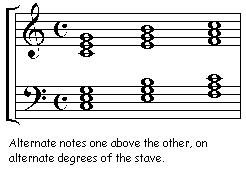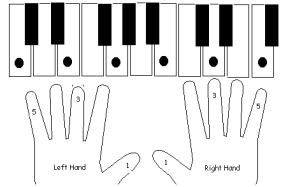Graphic Representation of Notes
 |
 In this section, we shall approach the study of notes from another perspective. The graphic representation of notes on a stave. You are familiar with the use of graphs for weather representation, or economic growth etc. Music has two elements: time and pitch. Thus the lines and spaces of the stave are used as horizontal rows, and the musical bars as vertical columns. If the note is placed on a line, the note after it may rise or fall. If it moves one step higher, it will go to a space. If from there it goes two steps higher, it goes to the space above, the current space. The middle and extreme fingers of both hands fall on alternate keys of the keyboard.
In this section, we shall approach the study of notes from another perspective. The graphic representation of notes on a stave. You are familiar with the use of graphs for weather representation, or economic growth etc. Music has two elements: time and pitch. Thus the lines and spaces of the stave are used as horizontal rows, and the musical bars as vertical columns. If the note is placed on a line, the note after it may rise or fall. If it moves one step higher, it will go to a space. If from there it goes two steps higher, it goes to the space above, the current space. The middle and extreme fingers of both hands fall on alternate keys of the keyboard.
To understand this, we shall use the seven note names in an alphabetic order:
 |
A, B, C, D, E, F, G, A, B, C, D etc.
C comes on a line, and the notes as they climb higher, which appear on lines, are alternate names after it: E, G, B, D etc. Since C comes on a line, D comes on a space. The notes that appear on spaces above it are alternate names following D: i.e. F, A, C, E etc.
 |
THE ALTERNATE KEYS ARE REPRESENTED BY "NOTES" ONE ABOVE THE OTHER EITHER ON LINES OR ON SPACES.
EXERCISES
Play the alternate keys/notes with fingers 1, 3 and 5. of the right hand. Fingers 2 and 4 play the keys/notes that are in between. PLACE YOUR THUMB (FINGER 1) ON THE LOWEST KEY/NOTE. If the lowest note is on a space, fingers 3 and 5 also have notes on spaces above it and 2 and 4 on lines. Similarly if the lowest is on a line, 3 and 5 too are on lines above it and 2 and 4 are on spaces.
The fingers of the left hand have to be numbered in the opposite direction.
Start by naming the finger numbers of the following notes, then say the finger number as you play. Be sure to say the correct finger number. In the beginning, you may get confused, therefore do not rush, but think before saying what finger number it is.
(You need not give the note names now)
exercises with alternate keys

Place your thumb on the Lowest Key - Middle C. 1,3,5 on lines; 2,4 on spaces

Place your thumb on the Lowest Key - D - 1,3,5 on spaces; 2,4 on lines.

Lowest Key - E - 1,3,5 on lines; 2,4 on spaces.

Lowest Key - F - 1,3,5 on spaces; 2,4 on lines.

Lowest Key - G 1,3,5 on lines; 2,4 on spaces.

Lowest Key - A - 1,3,5 on spaces; 2,4 on lines.

Lowest Key - B - 1,3,5 on lines; 2,4 on spaces.

Lowest Key - Upper C. - 1,3,5 on spaces. 2,4 on lines.
Practical Exercises
Learn the alternate names of the scale as follows:
Learn the alternate names of the scale as follows:
C D E etc.
Thus after C you must say E G, after D you must say F A etc.
For singers, use the Latin Names. - the idea is these have vowel endings and remain same even if the scale rises and drops. That is the scale is a sharp or flat one. Indian vocalists use Sa Re Ga, also for the same reason. These too hve vowel endings.
Do the same in the reverse order.
C i.e. C A F, B is B G E.
This practice will enable you to name the notes on the stave.
Remember, alternate names come on successive lines or spaces, one above the other in ascending order, or one below the other, in descending order.
At the next stage, you will find some practical exercises for playing on the keyboard. At the moment, we shall use only 5 finger patterns
In the exercise you will note different keys will be the lowest notes, to be played with the thumb/little finger (for L.H.). If it is on a line, then the third finger will play the note on the line above and the fifth finger will play the note on the 2nd line above the lowest note. On the other hand, if the lowest note is on a space, then the 3rd finger will be on the 1st space above it, and the 5th finger will be on the 2nd space above the lowest note.
Naturally, the 2nd and 4th fingers will be in between.
For singers, use the Do Re Mi names. Note that certain notes in the lower region will be beyond the reach of Soprano/ Tenors, and in the same way, the higher notes will be beyond the reach of Alto/Bass singers.
The Rhythm:
In the following exercises, the rhythm is indicated by letter C, which stands for 4 counts to a bar, and each count represents a crotchet.
The 3/4 Rhythm has three counts to a bar, and the first beat is accented. Each beat is one crotchet. See examples in Ex 37 to Ex 42.
In exercise 43, the example shows the 2/4 rhythm in which each bar consists of 2 crotchets, or equivalent.
The Traditional Counting Method
 |
In the first section, you were introduced to the Read-Count-Play method so that a sense of recognition of the note and its duration could be developed. The traditional method of counting beat numbers is useful especially, when playing the full music score with both hands. If read-count is not absorbed, then there is a likelihood, the numbers will be counted by rote, and not understanding the duration of the each individual note, in the score. To prepare you for this, this method is introduced to you in the second section. After, recognizing the graph of the notes, you should then play the music, with the graph concept, and keep time, by the traditional counting method, counting beat numbers.
DOWNLOAD THE FOLLOWING:
Music Exercises
Kodaly Book 2 Exercises in C scale and common rhythms
Kodaly files can be read in a Finale Software. If you want PDF files please write to me
at This e-mail address is being protected from spambots. You need JavaScript enabled to view it
| < Prev | Next > |
|---|
















